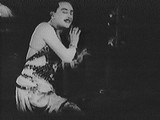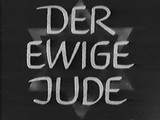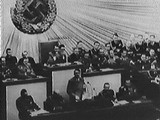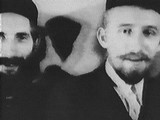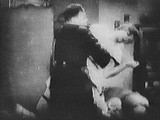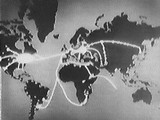|
I strongly believe the answer is no. Viewing the film produces a
ominous warning about what can happen when "produced" reality in a
reality-like medium is conceived as the reality itself. In this
respect, "Der ewige Jude" has become the ancestor of audio-visual
propaganda on TV which - like it happened in former Yugoslavia - has
instigated and legitimized genocidal killing in our time. 44 Through a comparison with such examples
an analysis of the film - with the hindsight of what were the dreadful
consequences of this piece of "produced reality" - we can help to
disclose those psychological patterns of genocidal mentality which
should be the ultimate aim of teaching about the Holocaust.
Notes and references
1. I would like to express my gratitude to
Professor Gerald Fleming, London, for his encouraging and challenging
criticism during the preparation of this paper.
2. Quoted from Daniel Jonah Goldhagen:
Hitler's Willing Executioners. Ordinary Germans and the Holocaust. New
York 1996, p. 179.
3. Robert Jay Lifton/Eric Markusen: The
Genocidal Mentality: Nazi Holocaust and Nuclear Threat. New York 1986.
4. This process is described in detail in my
Danish book: Foerermyten. Adolf Hitler, Joseph Goebbels og historien
bag et folkemord. Copenhagen 1996, 424 pages (The Führer-Myth.
Adolf Hitler, Joseph Goebbels and the History behind a Genocide). Basic
thinking and preliminary results are also presented in two articles in
German: Stig Hornshøj-Møller: "Die Entscheidung. Der antisemitische
Propagandafilm 'Der ewige Jude' und seine Bedeutung für den
Holocaust." In: Gerhard Maletzke/Ruediger Steinmetz (ed.): Zeiten und
Medien - Medienzeiten. Festschrift zum 60. Geburtstag von Karl
Friedrich Reimers. Leipzig 1995, p. 142-63. - Stig Hornshøj-Møller:
"'Der ewige Jude' (1940) - Legitimation und Ausloeser eines
Voelkermordes." In: Karl Friedrich Reimers (ed.): Unser Jahrhundert im
Film und Fernsehen. München 1995, p. 59-97.
5. Josef Joffe: "Goldhagen in Germany." The
New York Review, November 28, 1996, p. 18-21. - Cf. also Friedrich
Knilli/Siegfried Zielinski (ed.): Holocaust zur Unterhaltung. Anatomie
eines internationalen Bestsellers. Berlin 1982. - Friedrich
Knilli/Siegfried Zielinski (ed.): Betrifft 'Holocaust'. Zuschauer
schreiben an den WDR. Berlin 1983.
6. Facing History and Ourselves. A Guide to
the Film Schindler's List. Brookline, Massachusetts 1994.
7. David Welch: Propaganda and the German
Cinema 1933-1945. Oxford 1983. - Hilmar Hoffmann: "'... und zähle
nicht die Toten!'. Die Funktion von Film und Kino im Dritten Reich."
In: Hillmar Hoffmann/Heinrich Klotz (ed.): Die Kultur unseres
Jahrhunderts. Bd. 3. 1933-1945. Düsseldorf 1991, p. 151-83.
8. Martin Loiperdinger: Rituale der
Mobilmachung. Der Parteitagsfilm 'Triumph des Willens' von Leni
Riefenstahl. Opladen 1987. - Martin Loiperdinger/Rudolf Herz/Ulrich
Pohlmann (ed.): Führerbilder. München 1995.
9. Stig Hornshøj-Møller: "Der
ewige Jude." Quellenkritische Analyse eines antisemitischen Film.
Goettingen 1995 (= Beiträge zu zeitgeschichtlichen Filmquellen Bd.
2). - Cf. also note 4.
10. Cf. note 9.
11. Robert Jay Lifton: The Nazi Doctors:
Medical Killing and the Psychology of Genocide. New York 1986.
12. Cf. note 4 and 9.
13. Oral information from the executive of
Transit-Film, Munich, Karl Woerner (now retired).
14. Rebecca Lieb: "Nazi hate movies continue
to ignite fierce passions." New York Times, August 4, 1991. - Michael
Schmidt: Heute gehoert uns die Strasse. Der Insider-Report aus der
Neonazi-Szene. Düsseldorf 1994, p. 47-52. - Stig
Hornshøj-Møller: "Kultfilm der Neonazis. 'Der ewige Jude'
verbreitet immer noch 24 Lügen pro Sekunde." medium 3/1994, p.
31-33.
15. Cf. note 13.
16. Wilhelm Treue: "Rede Hitlers vor der
deutschen Presse (10. November 1938). Vierteljahrshefte für
Zeitgeschichte 6 (1958), p. 175-88.
17. As the Jews from Hitler's point of view
were not part of the German people, the Jewish Question consequently
was a matter of foreign policy.
18. Ralf Georg Reuth: Goebbels. München
1990, p. 399-400.
19. Cf. note 7.
20. Dorothea Hollstein: Jud Süß und
die Deutschen. Frankfurt/Main 1983. - Régine Mihail Friedmann:
L'image et son juif. Paris 1983.
21. A detailed description of the production
story of "Der ewige Jude" is given in my source-critical edition.
9
22. Ralf Georg Reuth: "Glaube und Judenhass
als Konstanten im Leben des Joseph Goebbels." In: Ralf Georg Reuth
(ed.): Joseph Goebbels Tagebücher 1924-1945. München 1992,
vol. 1, 20-46. - Cf. also Elke Froehlich (ed.): Die Tagebücher von
Joseph Goebbels. Sämtliche Fragmente. Bd. 1-4. München 1987.
23. Cf. note 4 and 9.
24. Froehlich 22 vol. 3, p. 612.
25. Froehlich 22, vol. 3, pp. 625-26.
26. Froehlich 22 vol. 3, pp. 628-29.
27. According to Felix Kersten, Heinrich
Himmler explicitly blamed Goebbels as the man who made Hitler take the
final decision to launch the Holocaust. Heinz Hoehne: Der Orden unter
dem Totenkopf. Die Geschichte der SS. München 1967, p. 298.
28. Fritz Hippler - executive director of the
film - in 1992 told the BBC in a TV-interview, that
Hitler wanted with this film so-to-say to prove that Jewry was a
parasitic race in humanity that should be excreted from the rest of
humanity. This film should be the evidence for this purpose. For more
than 13 months this film was changed, recut, enlarged and so on at
least more than a dozen times, not to speak of the different versions
of the commentary which became still more bloodthirsty, more
aggressive.
And the correctness of this testimony is corroborated in details by
the source-critical analysis of the production history of the film. -
For the reasons to date Hitler's final approval of the film, cf. the
literature listed in note 4.
29. Cf. note 4 and 9. - According to the rolling titles at the
beginning of the film "Der ewige Jude" was a "documentary film" which -
"shows us Jews the way they really are, before they conceal themselves
behind the mask of the civilized European." It used the slaughter
scenes as the emotional climax, claiming that the reason for showing
this "original footage," which belonged to the "most dreadful" ever
recorded by a camera, was justified by one argument: By means of seeing
for themselves the German people would at last "comprehend the truth of
Jewry." And according to the commentary - read by the authoritative
speaker of the Newsreels - "these pictures prove the cruelty of this
form of slaughter. It reveals the character of a race which conceals
its brutality beneath the cloak of pious religious practices."
"Der ewige Jude" contained nothing new, but was virtually a filmed
"black book" filled with examples from many years of anti-Semitic
traditions. As part of the propaganda set-up - and as with all feature
films of the day - one could purchase an illustrated program, the
Illustrierte Film-Kurier, with a summary of the contents of the film
which is reprinted here in order to give an impression of this, the
hate-film of all time:
The film begins with an impressive expedition through the Jewish
ghettoes in Poland. We are shown Jewish living quarters, which in our
view cannot be called houses. In these dirty rooms lives and prays a
race, which earns its living not by work but by haggling and swindling.
From the little urchin to the old man, they stand in the streets,
trading and bargaining. Using trick photography,
we are shown how the
Jewish racial mixture in Asia Minor developed and flooded the entire
world. We see a parallel to this in the itinerant routes of rats, which
are the parasites and bacillus-carriers among animals, just as the Jews
occupy the same position among mankind. The Jew has always known how to
assimilate his external appearance to that of his host. Contrasted are
the same Jewish types, first the Eastern Jew with his kaftan, beard,
and sideburns, and then the clean-shaven, Western European Jew. This
strikingly demonstrates how he has deceived the Aryan people. Under
this mask he increased his influence more and more in Aryan nations and
climbed to higher-ranking positions. But he could not change his inner
being.
After the banishment of the Jews from Europe was lifted, following
the age of Enlightenment, the Jew succeeded within the course of several
decades in dominating the world economy, before the various host
nations realized - and this despite the fact that they made up only 1
per cent of the world population. An excerpt from an American film
about the Rothschilds, made by Jews, reveals to us the cunning
foundations of their banking empire. Then we see how Jews, working for
their international finance, drive the German people into the November
Revolution. They then shed their anonymity and step out openly on to
the stage of political and cultural life. Thus the men who were
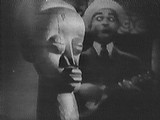 |
responsible for the disgraceful debasement of the German people are
paraded before us. Incontestable examples are shown of how they robbed
the country and the people of immense sums. As well as gaining
financial supremacy they were able to dominate cultural life. The
repulsive pictures of so-called Jewish "art" reveal the complete
decline of cultural life at that time. Using original sequences from
contemporary films, the degrading and destructive tendency of Jewish
power is exposed. For hundreds of years German artists have glorified
figures from the Old Testament, knowing full well the real face of
Jewry. How the Jew actually looks like is shown in scenes shot by Jews
themselves in a "culture film" of a Purim festival, which is still
celebrated today to commemorate the slaughter of 75,000 anti-Semitic
Persians, and the doctrine with which future Rabbis in Jewish schools
are educated to be political pedagogues. We look into a Jewish 'Talmud'
class and experience the oriental tone of the ceremony in a Jewish
synagogue, where Jews conduct business deals among themselves during
the holy services.
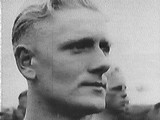 |
However, the cruel face of Judaism is most brutally displayed in the
final scenes, in which original shots of a kosher butchering are
revealed. These film documents of the inhuman slaughter of cattle and
sheep without anaesthesia provide conclusive evidence of a brutality
which is simply inconceivable to all Aryan people. In shining contrast,
the film closes with pictures of German people and German order which
fill the viewer with a feeling of deep gratification for belonging to a
race whose Führer is fundamentally solving the Jewish problem.
30. Froehlich 22 vol. 4, p. 315.
31. Willi A. Boelcke (ed.): Kriegspropaganda
1939-1941. Geheime Ministerkonferenzen im Reichspropagandaministerium.
Stuttgart 1966, p. 503 and 518.
32. Interview printed in three German film
magazines: Der Film No. 48/1940; Film-Kurier No. 279/1940; Filmwelt No.
49/1940. Reprinted in my source-critical edition 9 p. 309-12.
33. C.C. Aronsfeld: "'Perish Judah'. Nazi
Extermination Propaganda 1920-1945." Pattern of Prejudice 12, 5 (1978),
p. 22-23.
34. Cf. note 16.
35. The project was initiated by Professor
Niels Skyum-Nielsen who worked out a source-critical methodology for
using films in historical research. His Assistent Professor Karsten
Fledelius was responsible for the survey, testing the effects of using
the film for teaching the Holocaust and media critics.
36. Survey in the archives of the Institute
for the Scientific Film, Nonnenstieg 72, D-37075 Goettingen, Germany.
TEL.: +49-551-50240 - FAX: +49-551-5024400.
37. Karsten Fledelius, Stig Hornshøj-Møller:
"Nationalsozialistische Antisemitismus-Propaganda: Filmbeispiel 'Der
ewige Jude.'" Tagung der Koferenz für Geschichtsdidaktik, Berlin,
September 24-27, 1979 (unpublished).
38. Christoph B. Melchers: Untersuchungen zur
Wirkungspsychologie nationalsozialistischer Propagandafilme. Köln
1977.
39. Yizhak Ahren, Stig
Hornshøj-Møller, Christoph B. Melchers: "Der ewige Jude" oder wie
Goebbels hetzte: eine Untersuchung zum nationalsozialistischen
Propagandafilm. Aachen 1990.
40. Ahren et al. 39 p. 75-76.
41. Ahren et al. 39 p. 108-09.
42. Cf. note 5.
43. Cf. note 5.
44. During the summer of 1992 I closely
followed Serbian and Croate Television live on Cable-TV. My experiences
from viewing these programs as well as the whole mix of programs
finally made me realize the importance of "Der ewige Jude" as a crucial
factor for instigating the Holocaust.
| 


